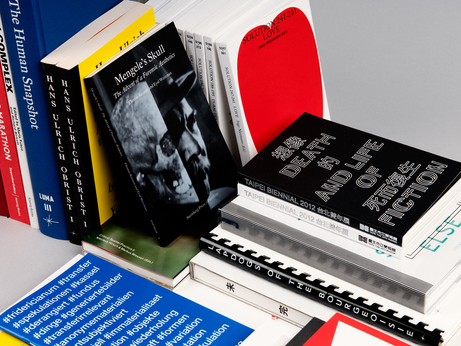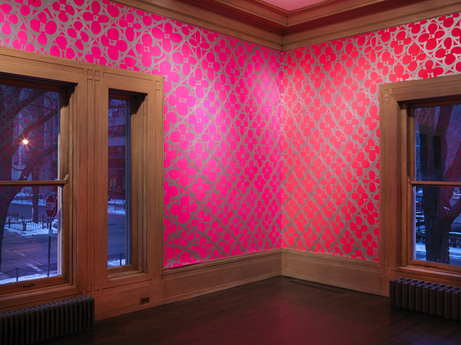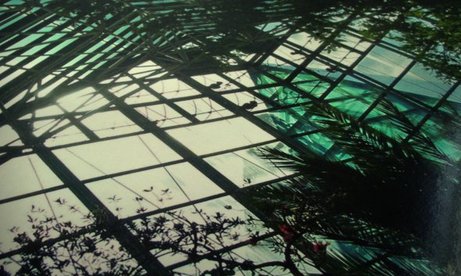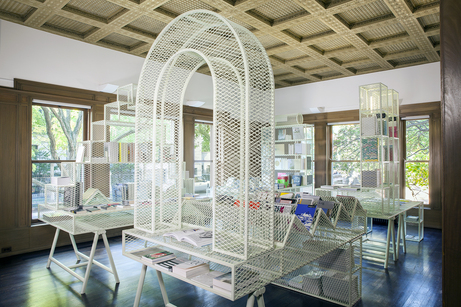Giving Shape
Zak Kyes
Feb 12, 2014
(6pm)
Talk
Please RSVP
In a new lecture titled “Giving Shape,” Graham grantee Zak Kyes explores historical references that inform his studio’s approach to publications, exhibitions and identities including Lina Bo Bardi, Seth Siegelaub, CalArts and the Visual Design Association, while also showing the studio’s recent and ongoing projects with the Architectural Association, Haus der Kulturen der Welt, 2012 Taipei Biennial, Lisbon Architecture Triennale, Fridericianum, and 8th Berlin Biennale. Zak Group uses the strengths and skills that come from graphic design to consider how designers can thoughtfully take part in the creative process where giving shape is its own way of creating culture.
First presented November 2013 at Centre Pompidou, Paris
Zak Kyes is a Swiss-American graphic designer and founder and director of the design studio Zak Group. Since 2006 Kyes has been the art director of the Architectural Association, London. In 2008, he co-founded Bedford Press, an imprint of AA Publications. Apart from studio projects, Kyes's critical practice encompasses publishing, curating, and site-specific projects. His current projects include the art direction of the 8th edition of the Berlin Biennale (2014). Kyes also teaches at the Architectural Association School of Architecture, London, and at ECAL (Ecole Cantonale d'Art de Lausanne).
Zak Group is a London-based design studio headed by Zak Kyes and Grégory Ambos. The office was formed in 2005 as a collaborative practice to explore the possibilities for design in the production of culture. The studio received the Inform Award for Conceptual Design in 2011 and was twice awarded the prize for the Most Beautiful Swiss Book in 2010. The studio's work has been included in the exhibitions Graphic Design Worlds (Triennale Design Museum, Milan, 2011), Wide White Space (CCA Wattis, San Francisco, 2011), The Malady of Writing (MACBA, Barcelona, 2009), Graphic Design for and Against Cities (Corner College, Zurich, 2009), and the 22nd International Biennale of Graphic Design (Brno, 2009).
Image: Brotherton—Lock, 2013. Courtesy Zak Group.

View of “Judy Ledgerwood: Chromatic Patterns for the Graham Foundation,” 2014, Graham Foundation, Chicago. Photo Tom Van Eynde.
Judy Ledgerwood
Feb 06, 2014
(6pm)
Talk
Please RSVP
On February 6, 2014, Judy Ledgerwood will discuss her practice and her current installation, Chromatic Patterns for the Graham Foundation, on view through April 5, 2014.
Judy Ledgerwood is a Chicago-based painter and educator. She is the recipient of numerous awards including The Richard H. Driehaus Foundation Award, an Artadia Award, a Tiffany Award in the Visual Arts, a National Endowment for the Arts Award, and an Illinois Art Council Award. Her work is represented in public collections including the Art Institute of Chicago, the Metropolitan Museum of Art, the Museum of Contemporary Art Los Angeles, the Milwaukee Museum of Art, the Museum of Contemporary Art Chicago, and the Kunstmuseum St. Gallen Switzerland. She received a BFA from the Art Academy of Cincinnati and a MFA the School of the Art Institute of Chicago. Ledgerwood is Director of Graduate Studies and Professor of Art Theory and Practice at Northwestern University.
For more information on the exhibition, Chromatic Patterns for the Graham Foundation, click here.

Chris Madak
lampo performance series
Feb 01, 2014
(8pm)
Please RSVP
In his first Chicago performance since 2011, Chris Madak will present new algorithmic and systems-based pieces for synthesizer, computer, and solo improviser.
Chris Madak (b. 1983, Massilon, Ohio) is a musician and electroacoustic composer active in Cleveland and Philadelphia and best known for his work as Bee Mask. Based in private systems and oblique strategies, Madak’s work endeavors to preserve and extend the countercultural heritage of experimental music. Madak draws on a varied technical vocabulary within experimental music, including handmade electronics and percussion, analog synthesis, concrète manipulations on tape and samplers, prepared guitar and piano, and digital signal processing. Rooted in rituals of listening and the convivial experience of phonographic sound in space from hi-fi’s to sound systems, Madak is motivated by an idea of music as studio art—distinct from what he believes are the arid textual formulas of sound art. He approaches performance as an opening of the experimental space of the studio onto the world. Madak has released several LPs on the Spectrum Spools imprint of Editions Mego and has published editions of his and others' work through his own Deception Island (2005-2011) and Pear Growers Series (2013-present) labels. He has performed throughout North America, Australia, Europe, and Japan, and collaborated with artists including Donato Dozzy, Surgeon, Charles Cohen, Outer Space, Autre Ne Veut, Laraaji, and Oneohtrix Point Never.
This performance is presented in partnership with Lampo. Founded in 1997, Lampo is a non-profit organization for experimental music, sound art, and intermedia projects. Visit lampo.org.


Judy Ledgerwood, preparatory studies for 'Chromatic Patterns for the Graham Foundation,' 2013
Judy Ledgerwood Opening Reception
Jan 23, 2014
(6pm)
Please RSVP
Please join us for a reception to celebrate the opening of Judy Ledgerwood: Chromatic Patterns for the Graham Foundation.
For more information on the exhibition, Chromatic Patterns for the Graham Foundation, click here.

View of the Graham Foundation bookshop designed by Ania Jaworska, Chicago, 2013. Photo Travis Roozée.
Bookshop Launch with Ania Jaworska & Holiday Book Sale
Dec 17, 2013
(6pm)
Please RSVP
The Graham Foundation is thrilled to announce the launch of its new architectural bookshop designed by Chicago-based Ania Jaworska. To celebrate, please join us for a reception and book sale. All books will be discounted up to 20% off or more!
Located in the former dining room of the foundation’s historic Madlener House, a 1901 Prairie style mansion in Chicago’s Gold Coast neighborhood, Jaworska’s installation is comprised of four bold mesh structures that display books and periodicals from the fields of architecture, design, art, and culture. In addition to recent hard to find publications, many titles are by the Graham Foundation’s international community of grantees and others are related to the Foundation’s exhibition program.
Ania Jaworska is an architect and educator. She currently teaches art, design, and architecture courses at the School of the Art Institute of Chicago and the University of Illinois at Chicago. She holds a master's degree in architecture from the Cracow University of Technology in Poland as well as the Cranbrook Academy of Art in Michigan. Her practice focuses on exploring the connection between art and architecture and her work explores bold simple forms, humor and commentary on conceptual, historic, and cultural references. Jaworska’s work was recently presented as part of 13178 Moran Street: Grounds for Detroit in Common Ground, the 13th International Architecture Exhibition in Venice (2012).
The installation was fabricated by Metal Magic.






 PREVIOUS POSTS
PREVIOUS POSTS